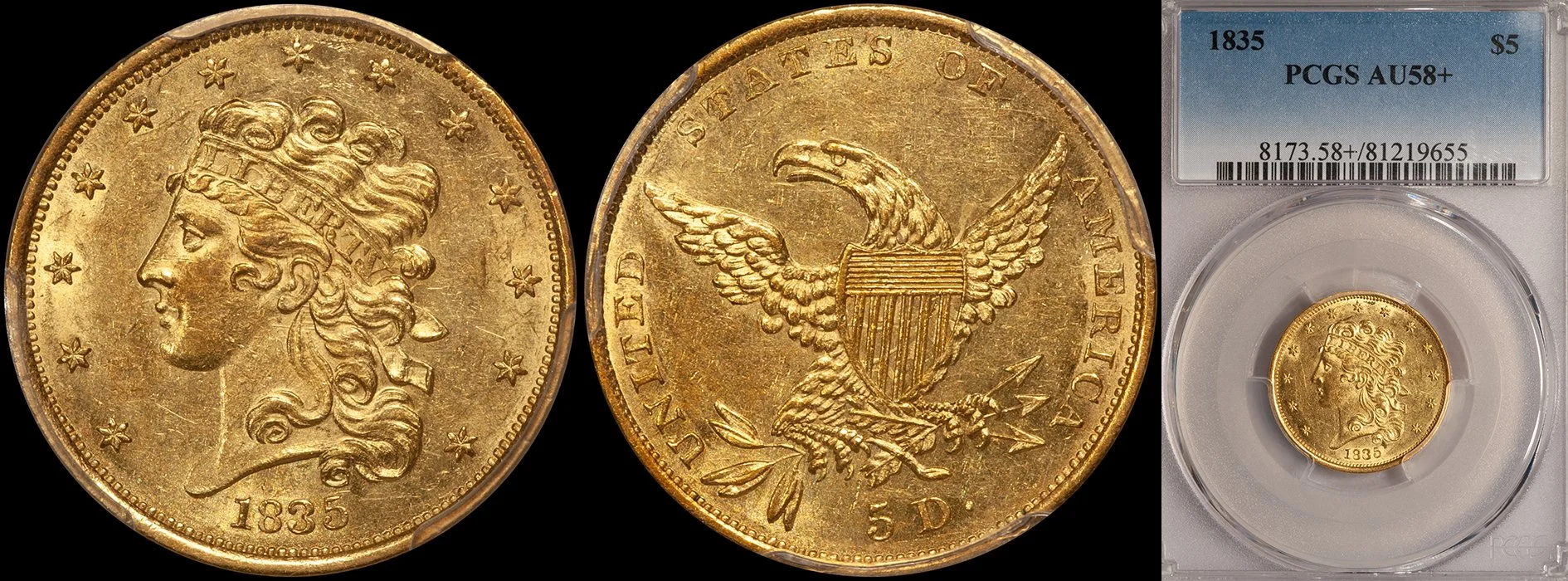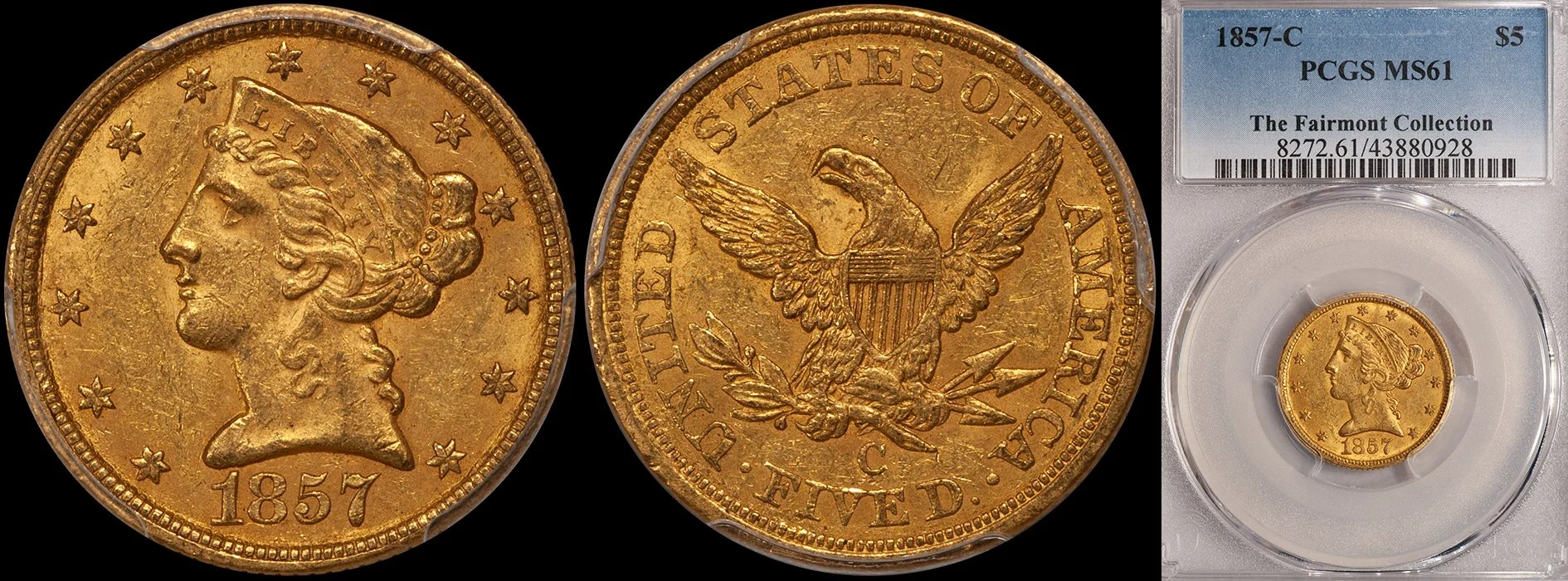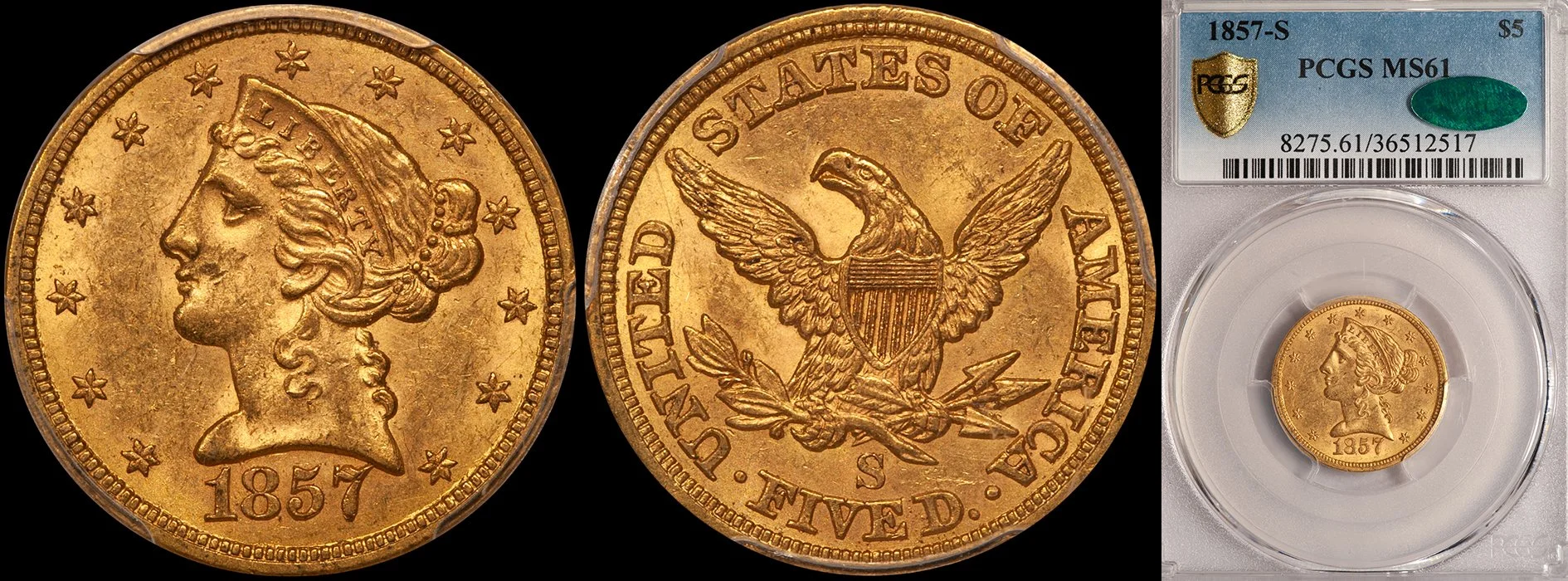What's the "Next Big Thing" in Rare Date Gold? Five Suggestions:
/In the last decade, we have seen a number of Next Big Things in the rare date gold market. We’ve seen New Orleans double eagles and Carson City double eagles. We’ve seen Civil War issues, and we’ve seen No Motto San Francisco eagles. In most cases, we’ve seen big demand spikes and subsequent price increases in these areas. What could be the Next Big Thing and why? Here are five suggestions with explanations.
1. New Orleans Half Eagles
Why the Next Big thing? This is a short-set (only 13 No Motto issues plus three With Motto issues) with no impossible rarities, yet completing a set is enough of a challenge to keep most collectors interested.
1842-O $5.00 NGC MS63 CAC
While they’ve never had the popularity they deserve, New Orleans half eagles are a series which already has a following. A radical shift in the supply/demand ratio would likely have a significant impact on this series as a number of issues are already very hard to find in EF to lower AU grades, let alone in high grades. Certain dates (most notably the 1842-O and 1847-O) are already very rare in properly graded AU, and another ten serious collectors with these two dates on their want lists are likely to have problems locating coins.
Of all the potential Next Big Things discussed in this article, New Orleans half eagles are the most popular. When I released the second edition of my New Orleans book a decade ago, I saw a surge in popularity in all gold coins from this mint, but most noticeably double eagles. Still, New Orleans half eagles trail their counterparts from Dahlonega by a considerable margin when it comes to demand.
With the release of my third edition likely to occur within the next year or so, I see the potential for another round of marketing pushes and someone (likely me!) is going to focus on New Orleans half eagles, given the rarity and excellent value these coins represent.
If I were a collector looking to get into this series, I’d focus on the two keys, the 1842-O and 1847-O. The 1855-O, 1856-O, and 1857-O are also very scarce to rare, especially with original color and choice surfaces.
2. San Francisco Gold Dollars
Why the Next Big thing? This is a very short set (only seven coins) which spans three different types between 1854 and 1870. The coins are historic, interesting, and affordable.
I’ve been a fan of gold dollars for years even though my aging eyes are having a harder time seeing them. Mintmarked gold dollars tend to be crudely made and very hard to find with good eye appeal, but the seven issues from San Francisco are a notable exception.
There are a variety of ways to approach this set, contingent on your coin budget. A modest budget can focus on coins in the AU grades and it can likely be completed for a total of $20,000-30,000. A larger budget can focus on nice Uncirculated coins with all seven issues in the MS61 to MS63 range. This set is completable in the $50,000-60,000+ range. Or, the ambitious large-budgeted collector can wait for Condition Census pieces in the MS63 to MS65 range and expect to assemble a set which has an overall cost of over $150,000-200,000.
1854-S $1.00 PCGS MS64+
I have noticed a considerable upswing in collector demand for many San Francisco gold issues, especially those with Gold Rush and Civil War connections. With five issues struck before the Civil War’s outbreak, San Francisco gold dollars have true Gold Rush association.
Their small size works against them but there are more than enough factors to compensate for this: low mintages, multiple design types, availability in above-average grades, good workmanship, and ease of completability.
3. No Motto Philadelphia Half Eagles
Why the Next Big thing?Old, affordable, well-made and completable: the No Motto half eagle coinage from Philadelphia presents collectors with an interesting option.
Philadelphia gold coinage has the unfair reputation of being boring. While it doesn’t have the “sexy” backstory of the Southern branch mints or the historic association of Carson City, I personally find Philadelphia gold coinage to be highly desirable and for a number of reasons.
Of all the major denominations which were struck at the Philadelphia mint in the 1838-1866 era, I think half eagles are the most collectible. This denomination began production of the Liberty Head design in 1839 and after a modification in 1840, this type continued through 1866. The dates from the 1840’s and 1850’s are, with a few exceptions, mostly available in the higher circulated grades for $1,000-3,000 and many can be found in the lower Uncirculated range for less than $7,500.
The Civil War era dates are the keys in any No Motto Philadelphia half eagle set. The 1862 is scarce, the 1863 and 1864 are rare, and the 1865 is very rare. Still, all four of these dates can be found in the EF40 to AU53 range with patience.
What the P mint half eagles lack in sex appeal they make up for with cosmetic appeal. The dates from the 1840’s and 1850’s are seen with natural color and above-average surfaces far more often than the issues from the branch mints, and collectors who are eye appeal-oriented will like the way that choice P mint half eagles look.
1856 $5.00 PCGS MS65+ CAC
This series lends itself to a wide range of budgets. As an example, I just sold the finest known 1856-P half eagle (graded MS65+ by PCGS and approved by CAC) for a high five-figure sum. But I have handled really attractive AU58 examples of this date which were priced in the $1,250-1,500 range.
4. Non-Carson City Type Two Double Eagles
Why the Next Big thing?This type is short-lived and relatively affordable with big, historic coins being the norm. Most Type Two double eagles are condition rarities which become scarce in the higher AU grades, and which are rare to very rare in Uncirculated.
Type Two double eagles were the Next Big Thing in the 1990’s and early 2000’s. They were extensively promoted and marketed by a large Texas firm who did an excellent job of creating new set-building clients.
The promotion of Type Two double eagles stopped a while ago and now this type feels musty and underappreciated. A new updated book would work wonders for introducing a new generation of collectors to Type Two double eagles.
Type Twos were struck from 1866 through 1876 at three mints: Philadelphia, San Francisco and Carson City. The CC double eagles of this design have seen their own promotion in recent years and are currently at all-time high price levels.
Nice quality Philadelphia and San Francisco Type Two double eagles are a stagnant market with prices for some issue cheaper than at any time I can recall.
1868-S $20.00 NGC MS62
The Philadelphia issues I like include the 1868, 1868, 1870, and 1871. The San Francisco issues which are the best value in my opinion include the 1867-S, 1868-S, and 1873-S Open 3.
5. Significant Die Varieties
Why the Next Big thing?Die variety collecting in other series is well-established and has never been more popular. Gold varieties are interesting, seemingly undervalued, and many are now recognized by PCGS and/or NGC. But there are caveats…
The high price of gold coinage has dissuaded most collectors not named Harry Bass from collecting Liberty Head gold by die variety. But there are other expensive series with avid variety collectors (Large Cents, Flowing Hair half dollars). What’s missing in gold coinage? An all-encompassing reference work.
I’ve written about Liberty Head gold varieties before. In the last five years, I’ve noted more collectors focusing on varieties. As an example, when I list significant naked-eye Dahlonega varieties for sale on my site, these tend to move quickly. My third edition Dahlonega book contains detailed descriptions on these varieties and many are now recognized by PCGS (but not NGC).
1852/1852 $20.00 NGC AU55 CAC
There are other series which contain varieties which are becoming popular with collectors. The foremost of these is the popular Type One double eagle series which contains recognized varieties such as the 1852 Doubled Date, 1854 Repunched Date, and 1859-S Double Die Obverse. Die variety collectors seem to be most attracted to Dahlonega half eagles, a series which contains a number of well-documented naked-eye varieties.
While significant die varieties are probably the least likely of these five categories to become the Next Big Thing in rare date gold, I do see selected varieties becoming readily accepted in the coming years.
What do you think the Next Big Thing in the rare date gold market is? Please share you opinion in the comments section below or email me at dwn@ont.com. And if you’d like to work on a set of coins which might just be the Next Big Thing, feel free to phone me at 214.675.9897.


















